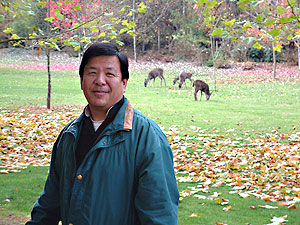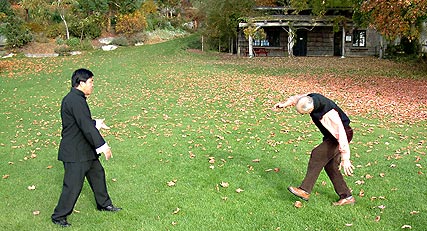|
 As
a young man Master Wang studied several external martial arts and
taught self defense in the Taiwanese army. Later he began the study
of tai chi with several masters in Taiwan. His primary influence
was Grandmaster Huang of Malaysia. As
a young man Master Wang studied several external martial arts and
taught self defense in the Taiwanese army. Later he began the study
of tai chi with several masters in Taiwan. His primary influence
was Grandmaster Huang of Malaysia.
Master Wang competed regularly in push hands events
in Taiwan, with both national and international participants.
He was push hands champion
for several years winning international competitions. However, he
felt discouraged because so much physical force and technique
was required
to defeat an opponent.
He had read the
tai chi classics which talked about softness and "four ounces moving
a thousand pounds", but this was not evident in tai chi push hands in present use.
Only after meeting Grandmaster Huang did he realize that soft power
could be achieved. He studied with Huang, when he visited Taiwan and
realized he had to give up his prior emphasis on strength and technique.
After arriving
in Canada, he had the time and opportunity to research tai chi
and improve his skills. He developed Search
Center to replace push hands. Search Center emphasizes use
of chi energy and softness rather than physical strength. The hands
no longer push, but rather act as antennae or "feelers" to detect
a partner's center. The power comes from internal chi energy and
is expressed through a person's center. This center is composed
of the head, spine, dantien, and extends to the ground.
 Master Wang teaches that tai chi must have a philosophical basis and
that originates from Daoist concepts of softness and letting go. The
softness must be practiced through regular tai chi form which also cultivates
internal chi energy. He uses the thirty-seven posture Yang form condenced
by Grandmaster Cheng Man-ching. He teaches both left and right sides.
Finally he believes that the philosophy and practice must be integrated
with useful applications which he calls search center. The three aspects
are inter-related. If one wants to successfully learn search center,
then their form must be correct and vice versa. He is one of very few
tai chi masters who actually use chi and not li (physical force). Master Wang teaches that tai chi must have a philosophical basis and
that originates from Daoist concepts of softness and letting go. The
softness must be practiced through regular tai chi form which also cultivates
internal chi energy. He uses the thirty-seven posture Yang form condenced
by Grandmaster Cheng Man-ching. He teaches both left and right sides.
Finally he believes that the philosophy and practice must be integrated
with useful applications which he calls search center. The three aspects
are inter-related. If one wants to successfully learn search center,
then their form must be correct and vice versa. He is one of very few
tai chi masters who actually use chi and not li (physical force).
His form and search center are based on seven fundamental principles.
Relaxation, Concentration, Center, Balance, Proportion, Circle, and
Coordination. He feels these principles are applicable to all tai chi
styles and indeed all martial arts. His principles have some fundamental
differences to tai chi as taught in most schools. He espouses three
possible weight distributions: 100%, 0%, and 50%. This is in contrast
to the concept of 70-30% distribution. His ideas require a center which
has very minimal movement and no leaning of the body. He also teaches
one to turn the center first and then shift weight as opposed to shifting
weight and then turning. Without maintaining a center there can be no
balance and without balance there can be no power. His extraordinary
martial skills attest to the validity of his tai chi principles.
|